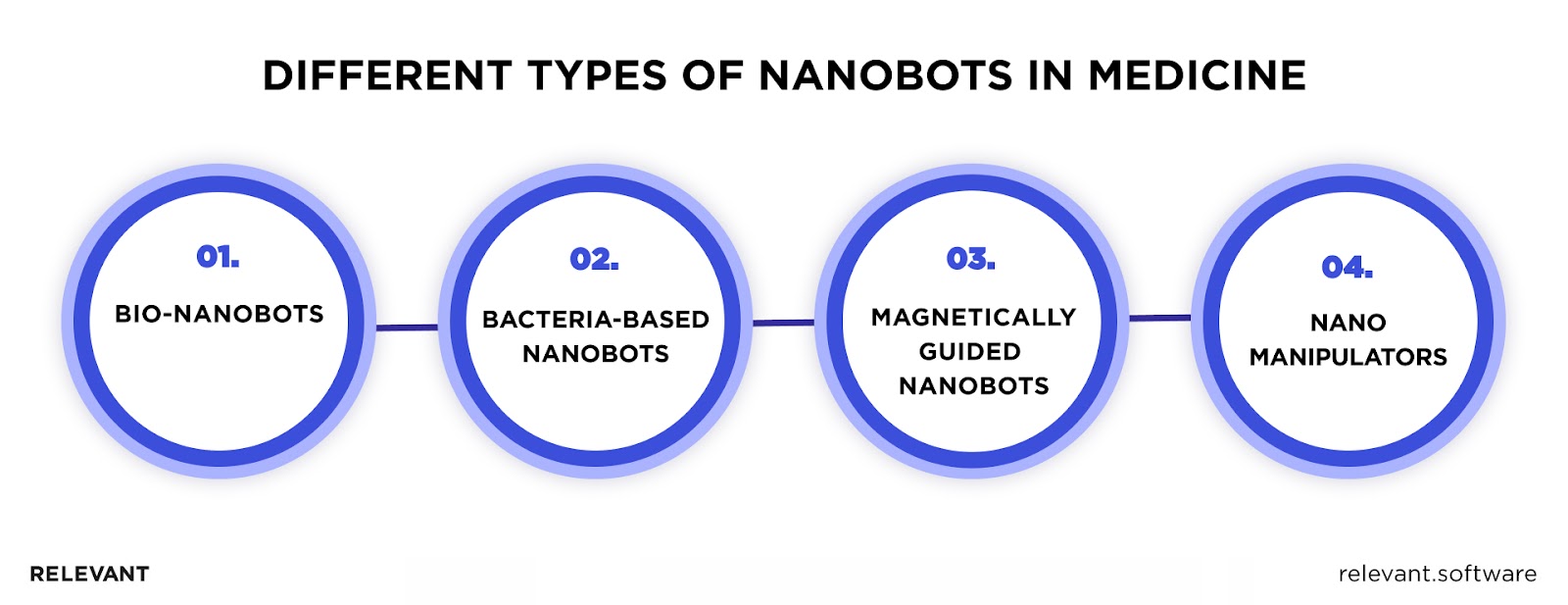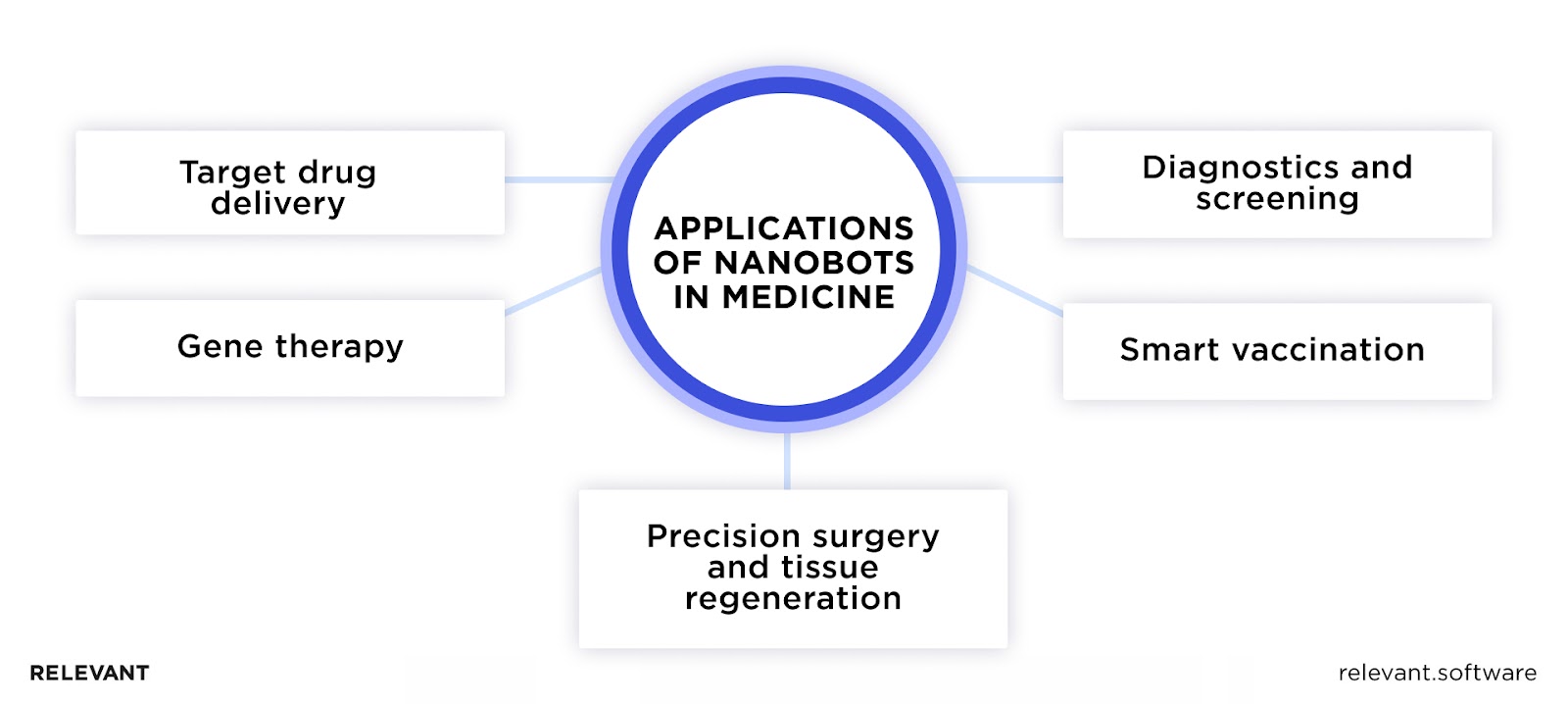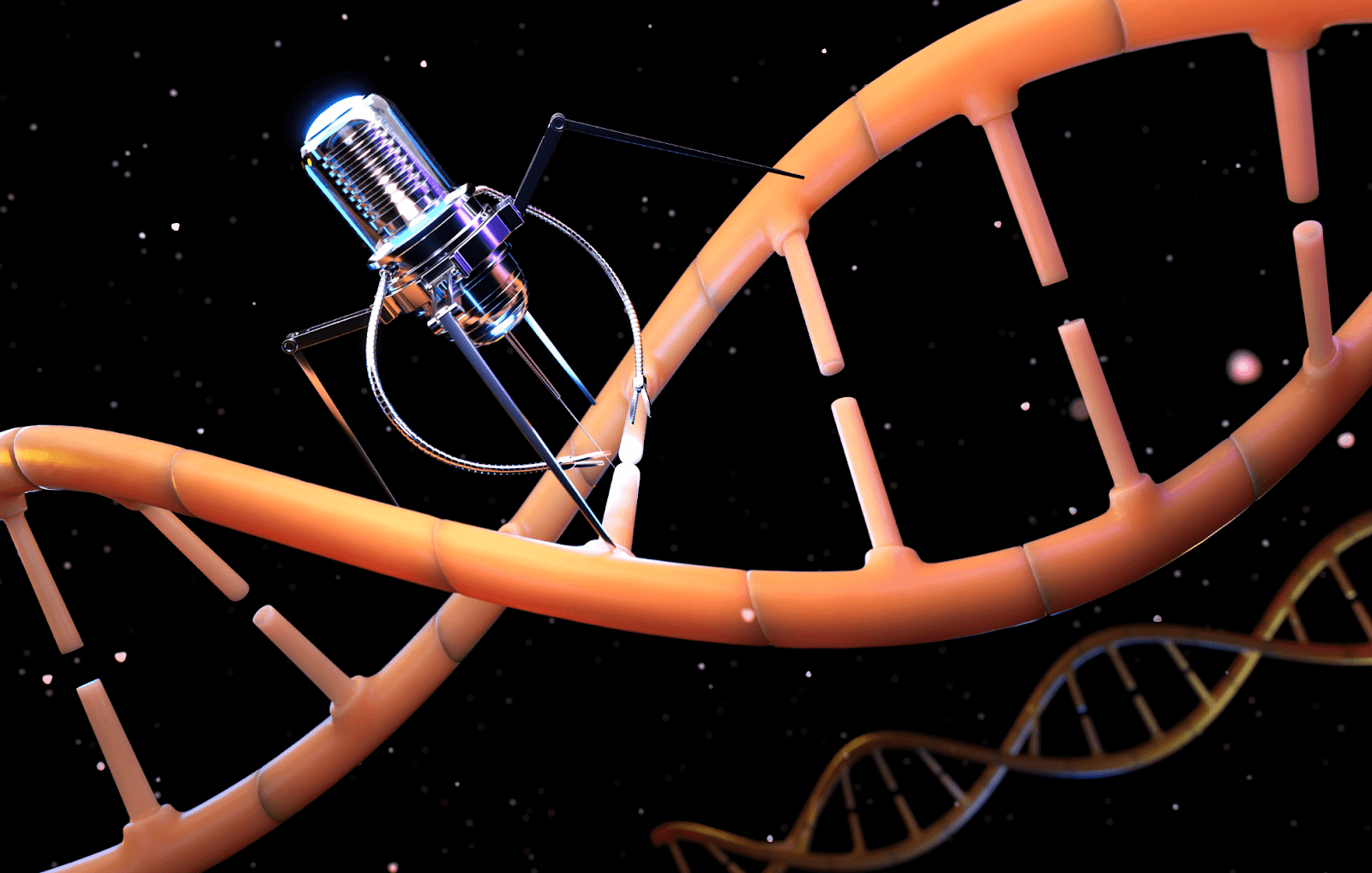The Promise and Challenges of Using Nanobots in Medicine
Updated: June 4, 2025
Imagine a world where microscopic robots, no larger than a speck of dust, navigate our bloodstream, diagnosing diseases before they manifest and delivering precise treatments to affected cells. This isn’t the plot of a sci-fi movie—it’s the transformative promise of nanobots in medicine.
As the nanotechnology market, valued at $10.63 billion in 2022, is projected to soar to $31.40 billion by 2030, the nanobots market growth is undeniable. But why should this matter to you? The United Nations paints a grim picture: by 2030, over five billion people could lack access to essential healthcare services. Nanobots might just be the breakthrough we need, bridging the gap between advanced MedTech and global health needs.

We provide companies with senior tech talent and product development expertise to build world-class software. Let's talk about how we can help you.
Contact usTable of Contents
What Are Nanobots in Medicine?
Few innovations in medical science have captured the imagination quite like nanobots. But what are nanobots in medicine, and why are they causing so much noise?
A pivotal innovation in nanorobotics, nanobots are minuscule robots, often smaller than a hair’s width. They are composed of atom chains and use quantum computing and advanced healthcare analytics to operate. These tiny machines can navigate our bodies with unmatched precision, detecting and treating diseases, even though their size—ranging between 50-100 nanometers—makes them invisible to the human eye.
Creating these molecular-level nanorobots demands cutting-edge technology and deep medical knowledge. Even though they’re super small, nanobots can send electrical signals from computers directly to our organs if they have the right information. Think of nanobots as special delivery workers inside us. They move smoothly and can go right to certain cells, spot problems, and even do surgeries all by themselves.

The history of nanobots in medicine shows how we turned cool sci-fi ideas into real tools that could make surgeries safer, drug delivery more accurate, and spot diseases long before they show any symptoms.
Nanobots vs. robots vs. xenobots
Nanobots, robots, and xenobiotics all come from nanotechnology, each serving distinct roles. While many sectors already use nanorobotics in some form today, we’re still figuring out how to realize the full potential of next-gen robots.
Nanobots
Nanobots are micro-machines that can gather and process data using external energy. Considering the efficiency and energy-saving benefits of nanobots used in medicine, they outshine traditional medical approaches. Moreover, nanobots in researching medicine are paving the way for groundbreaking discoveries and novel therapeutic techniques.
Robots
While nanobots operate on the nanoscale, robots are their larger counterparts. These systems, guided by human commands or gestures, have seamlessly integrated into many sectors, including healthcare. Consider surgical robots that assist surgeons in complex procedures, ensuring precision and reducing human error. They’re like high-tech helpers for doctors that can enhance patient care.
Xenobots
They’re a groundbreaking blend of biology and robotics, made from living cells to create tiny, programmable organisms. Unlike traditional robots, these lifeforms are more adaptable and biocompatible to human bodies. For instance, imagine xenobots designed to deliver medication precisely within the human body, targeting only diseased cells and leaving healthy ones untouched. Right now, certain antibiotics contain xenobiotics that neutralize harmful viruses.
Nanobots in Medicine: Current Applications
The role of nanobots in various medical scenarios is under close examination in pursuit of unlocking their full potential. Currently, the main medical fields where nanobots are applied are disease diagnosis, treatment, drug delivery, and surgery. As technology and healthcare software development advances, the use of nanobots in medicine could transform cancer care, diabetes management, wound healing, and dental care, among other areas. So, let’s see how they make a difference in healthcare today.

Drug Delivery Systems
Imagine that medication goes exactly where it’s needed without affecting healthy cells—this is the groundbreaking promise of medical nanorobots. Traditional drug delivery methods often have side effects, as they can’t distinguish between sick and healthy cells. Nanobots change the game by delivering drugs with laser-like precision.
Here’s how it works: nanorobots are programmed to recognize specific markers of diseased cells. Once they find their target, they release the medication directly into the affected cells. This not only maximizes the drug’s impact but also minimizes harm to healthy tissues. In essence, nanobots medicine offers a smarter, more efficient way to treat diseases, from cancer to chronic conditions. It’s like having a GPS that guides your medicine straight to the sick parts.
And real-world applications are already emerging. For instance, Tandem Nano develops nano-delivery systems that bring specific remedies directly to human cells or tissues.
Diagnostic Procedures
The advantages of nanobots in medicine for diagnosis are immense, particularly in the early detection of life-threatening diseases like cancer and heart disease. A simple injection of nanorobots could roam your body, seeking out early signs of trouble long before symptoms appear.
How? Software engineers program these nanobots to identify abnormal cells or markers in the bloodstream. For instance, in the case of cancer, they can detect tumor cells at a very early stage, allowing for prompt and more effective treatment. In heart disease, they can identify plaque buildup in arteries before it becomes a significant issue.
Surgery and Repair
Nanorobotics can give surgeons an extra hand during complex operations, making the whole process faster, less painful, and more affordable. They’re good at specific jobs like taking out harmful stuff or getting medication exactly where it needs to go. With nanobots helping out, there’s a lower chance of something going wrong during the surgery, which means fewer repeat operations.
As for tissue repair and regeneration, nanobots can speed up the healing process by half or more by delivering specialized substances that help tissues grow back faster and more efficiently. It means less time for healing and a quicker return to normal life. For instance, NanoScientifica invested years in developing nanobots that operate at a breakneck speed, far outpacing conventional treatments. Yes, this is the future that nanobots’ medical applications can offer to modern healthcare.
Gene Therapy
Once a concept described in science fiction, it’s now a thriving field in medicine, with nanobots at the forefront of this revolution. Researchers employ them to tackle genetic diseases at their very root—our DNA. Soon, with the help of nanorobots, healthcare professionals can treat inherited diseases like cystic fibrosis or muscular dystrophy in a radically new way. Instead of just managing symptoms, these tiny mechanisms can correct underlying genetic flaws.

Nanobots in researching medicine are showing promise in delivering gene-editing tools like CRISPR directly to the affected cells. By doing so, they can replace or repair the faulty genes, essentially rewriting the script of life. While the full potential of this technology is still under exploration, early studies are encouraging. For example, researchers at the University of California, San Diego, experimented with nanobots that can deliver a payload of gene-editing tools to treat genetic blood disorders.
The implications are breathtaking. Using nanobots medical solutions in gene therapy could mean more effective treatments, fewer side effects, and even a win over certain genetic diseases.
Smart Vaccination
Powered by nanorobotics, smart vaccination can boost the human immune system. Take, for example, the Pfizer-BioNTech COVID-19 vaccine, which employs iron nanoparticles to transport RNA molecules into our bodies. These nanoparticles target only our white blood cells. Once there, the cells produce proteins mimicking the coronavirus’ spikes, enabling them to recognize and neutralize the virus more effectively.
Thus, nanobot in medicine application equips our immune system to combat virus mutations more effectively, providing a level of protection that traditional vaccines can’t match. Integrating nanotechnology into vaccination protocols could mark a paradigm shift in public health, offering more robust and long-lasting immunity.
Challenges and Ethical Considerations
While the promise of targeted treatments and rapid healing is very appealing, it’s crucial to pause and consider the challenges and ethical dilemmas of nanorobotics. We can’t ignore such concerns as safety, accessibility, and ethical use.
Technical Challenges
While the promise of nanorobots in medicine is awe-inspiring, it’s crucial to tackle the technical roadblocks that stand in the way of its development and mass adoption.
First, we have to think about control. Ensuring that these microscopic robots go only where they’re needed, doing only what they’re programmed to do, requires jewelry work. And a single misstep could have serious health implications.
Then there’s the issue of biocompatibility. The materials used to make nanobots for medicine should be safe for the human body. We don’t want them causing inflammation or other harmful reactions.
Lastly, it’s the cost of nanobots in medicine. Making intelligent nano mechanisms on a large scale isn’t cheap. Then, the manufacturing process needs to be both high-quality and cost-efficient, which is easier said than done. Right now, the cost is a big obstacle to making the use of nanobots in medicine widespread.
Ethical and Legal Concerns
Just like machine learning in healthcare, nanorobots can do a lot for medicine, but they also bring up some ethical considerations.

Patient consent is a particularly tricky issue when it comes to using nanobots in medicine. Traditionally, doctors explain the risks and benefits of a treatment, and patients give their consent based on this information. But how do you explain the potential risks of a technology so new and complex that even experts are still learning about its full range of capabilities and threats? And how do you do it in a way that a person without a technical background can understand?
Health information confidentiality is a top priority in healthcare, and this becomes even more critical with the use of nanobots. They will collect a lot of personal health data, and the decent protection of this information should be a must. To build trust, both nanobot manufacturers and healthcare providers must guarantee robust security measures to keep this sensitive information safe from start to finish.
And what about legal issues? Imagine a scenario where a nanobot malfunctions during a medical procedure. Who will be responsible? Is it the doctor, the company that made the nanobot, or the software development team that programmed it? Current laws aren’t fully prepared to answer these complex questions. Without a robust legal framework, we risk entering murky ethical waters that could undermine public trust in this revolutionary technology.
Future of Nanobots in Medicine
Nanorobots are a topic of intense interest, promising to remodel healthcare in ways we can only begin to imagine. One of the most exciting prospects is real-time health monitoring. Nanobots in your bloodstream could spot early signs of disease and send alerts at the first hint of trouble. It will help doctors to diagnose and treat patients in the early stages.

Medical nanorobots could also take personalized medicine to the next level. By analyzing patient’s unique genes, they could tailor drug delivery to make it more effective while minimizing side effects. This is one of the many advantages of nanobots in medicine. They could also help treat mental health conditions by delivering neurotransmitters exactly where they’re needed, potentially easing symptoms of depression and anxiety.
What’s more, the neutralization of toxins or pollutants in the human body is another promising area where nanobots can be very helpful. It could be a lifesaver, especially for people who work in or live near polluted areas.
But let’s not forget that the true value of nanobots in medicine goes beyond just fixing what’s broken. They could actually make us better, stronger, and healthier. Sure, there are hurdles like technical challenges and ethical dilemmas, but the potential to improve human health is too big to ignore. So, it’s definitely worth keeping the research and investment.
Nanobots in Medicine: Bottom Line
Even though nanorobots are tiny, they could help us fight big health problems. Repairing tissues at the cellular level and managing chronic illnesses like diabetes will dramatically advance healthcare practices. The experts are still figuring out all the ways nanobots in medicine can benefit the industry, but one thing’s for sure: the future is bright.
If you’re looking to join the bandwagon of healthcare innovation which is already unstoppable, now’s the time. At Relevant Software, we offer healthcare IT consulting services to help businesses stay at the forefront of medical advancements. We follow the latest software development trends to build impactful solutions that help organizations address the challenges they face today and keep pace with innovations that shape our future.
Also, read more about healthcare scheduling software systems.
FAQs
Our core services:
Do you want a price estimate for your project?
Do you know that we helped 200+ companies build web/mobile apps and scale dev teams?
Let's talk about your engineering needs.
Write to us











